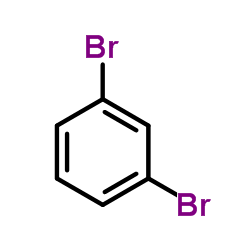1,3-Dibromobenzene

1,3-Dibromobenzene structure
|
Common Name | 1,3-Dibromobenzene | ||
|---|---|---|---|---|
| CAS Number | 108-36-1 | Molecular Weight | 235.904 | |
| Density | 1.9±0.1 g/cm3 | Boiling Point | 217.5±13.0 °C at 760 mmHg | |
| Molecular Formula | C6H4Br2 | Melting Point | -7 °C | |
| MSDS | Chinese USA | Flash Point | 93.9±0.0 °C | |
| Symbol |

GHS07 |
Signal Word | Warning | |
|
Hepatotoxicity of brominated benzenes: relationship between chemical structure and hepatotoxic effects in acute intoxication of mice.
Arch. Toxicol. 72(2) , 97-103, (1998) Brominated benzenes appear in the environment and human tissues. Their detection in the environment may be as a result of their usage, e.g. hexabromobenzene (HBB), and as products of HBB degradation or metabolism. The aim of this study was to compare liver im... |
|
|
Comparison of hepatotoxicity of 1,2-, 1,3- and 1,4-dibromobenzenes: the dynamics of changes of selected parameters of liver necrosis in acute poisoning in mice.
J. Appl. Toxicol. 16(1) , 35-41, (1996) Various doses of dibromobenzene isomers (1,2-dBB, 1,3-dBB, 1,4-dBB) were administered (i.p.) to BALB mice. The levels of reduced glutathione (GSH) and malondialdehyde (MDA) in the liver, and glutamate-pyruvate transaminase (GPT) (EC.2.6.1.2) gamma-glutamyltra... |
|
|
Microwave-assisted Suzuki coupling on a KF-alumina surface: synthesis of polyaryls. Microwave-assisted Suzuki coupling on a KF-alumina surface: synthesis of polyaryls. Basu B, et al.
Tetrahedron Lett. 44(19) , 3817-20, (2003)
|
|
|
Synthesis of [n]- and [n.n]cyclophanes by using Suzuki-Miyaura coupling.
J. Org. Chem. 67(15) , 5333-7, (2002) Reaction of the bis-9-BBN adduct of several dienes with 1,3-dibromobenzene via Suzuki coupling leads to a series of [n]metacyclophanes ranging in size from 10 to 17 atom members. In each case, two carbon-carbon bonds are formed in one reaction vessel. However... |
|
|
Biochemical alterations as measures of acute and subacute hepatotoxicity of 1,3-dibromobenzene in rat.
Arch. Toxicol. 71(1-2) , 99-106, (1996) Rats were used to study acute and subacute hepatotoxicity of 1,3-dibromobenzene (1,3-dBB). In the single-exposure experiment, maximum hepatic 1,3-dBB concentrations were found to occur 1 to 12 h after the exposure, depending on the dose. Maximum concentration... |
|
|
The disposition and metabolism of 1,3-dibromobenzene in the rat.
Chemosphere 39(13) , 2229-38, (1999) The distribution, excretion and metabolism of 1,3-dibromobenzene following a single i.p. administration to rats 100 or 300 mg/kg was investigated using radiotracer [3H] and GC-MS technique. After 72 hours about 74 to 90% were excreted in urine. The highest ra... |